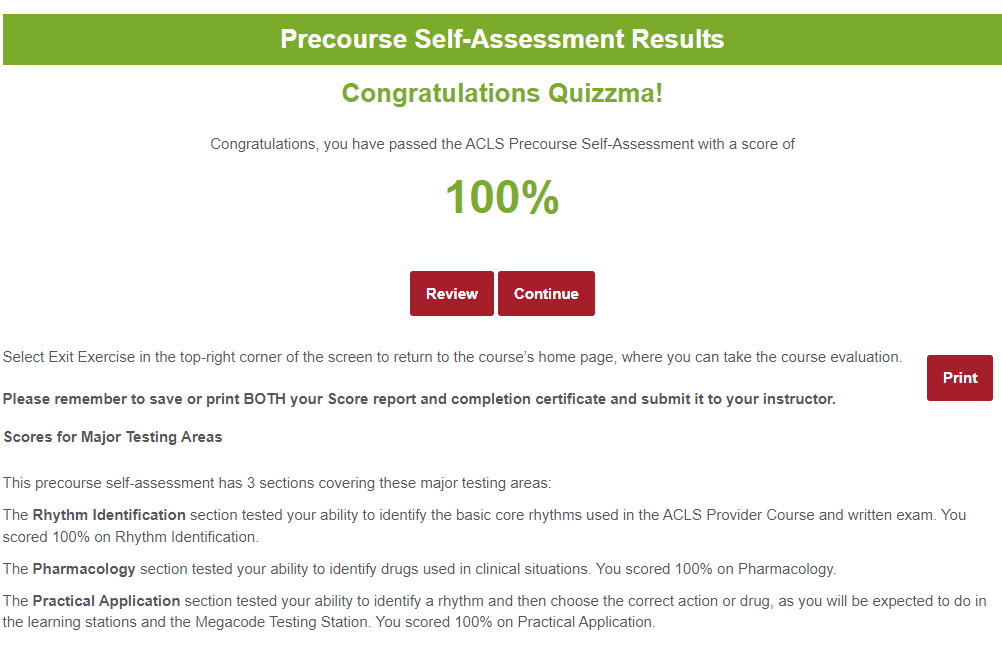
Welcome to the ACLS Precourse Self-Assessment Test Answers page! The Advanced Cardiovascular Life Support (ACLS) Precourse Self-Assessment is a vital online tool designed to gauge a student’s proficiency and understanding in three critical areas: rhythm recognition, pharmacology, and practical application.
Completing the assessment before the course helps students identify strengths and weaknesses and focus on areas that need more review and practice.
To enroll in the ACLS Course, you must achieve a score of 70% or higher on the Precourse Self-Assessment and present your report at the beginning of the class.
ACLS Pretest Answers
Section 1: Rhythm Identification Answers
For section 1, identify the rhythm by selecting the single best answer.
Choose the correct option and select submit.
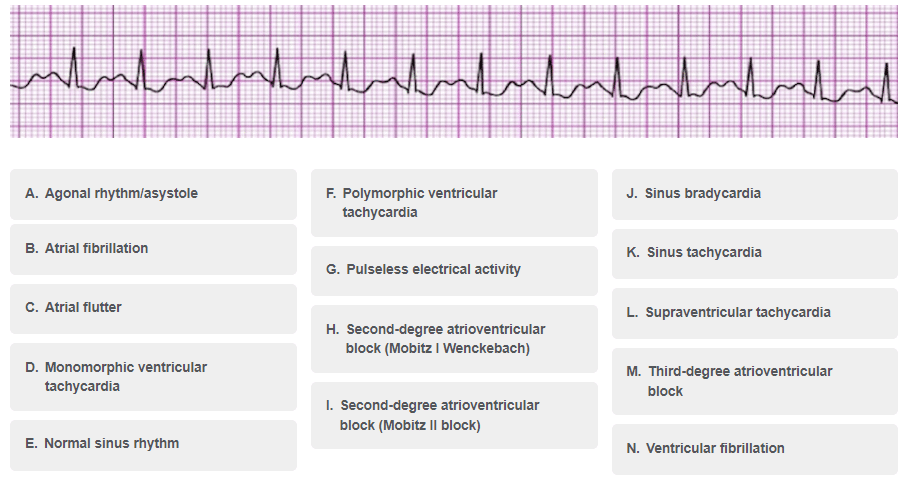
Answer: Sinus tachycardia.
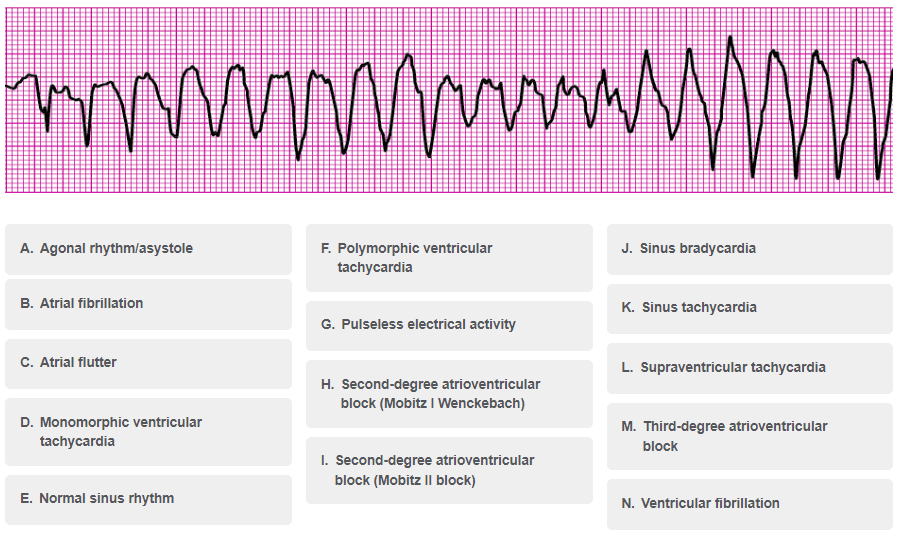
Answer: Polymorphic ventricular tachycardia.
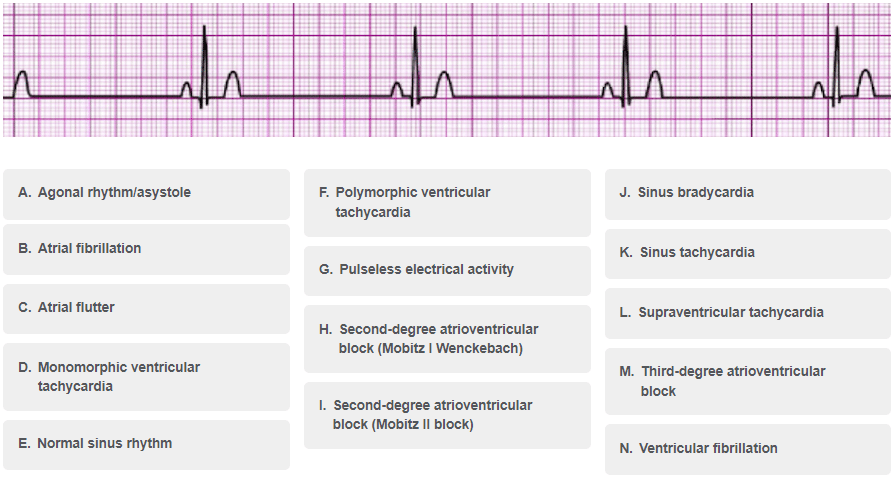
Answer: Sinus bradycardia.
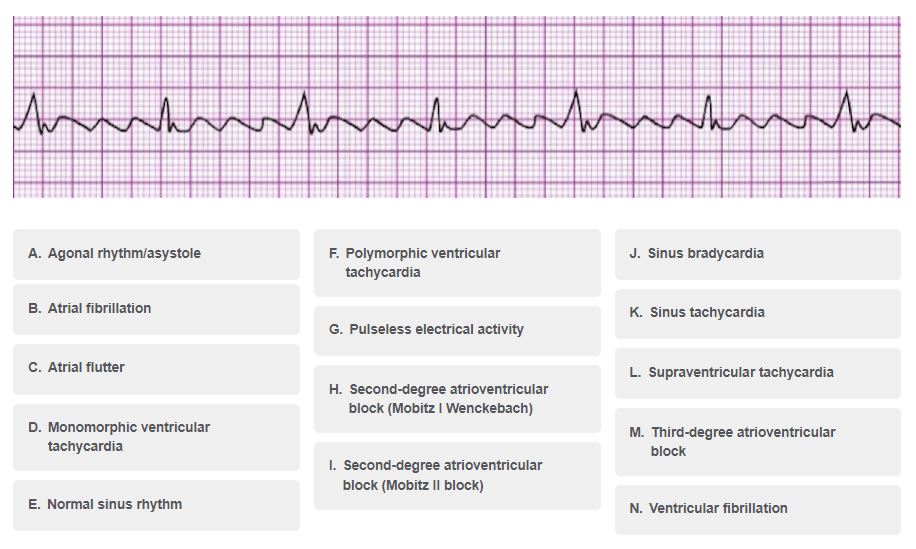
Answer: Atrial flutter.
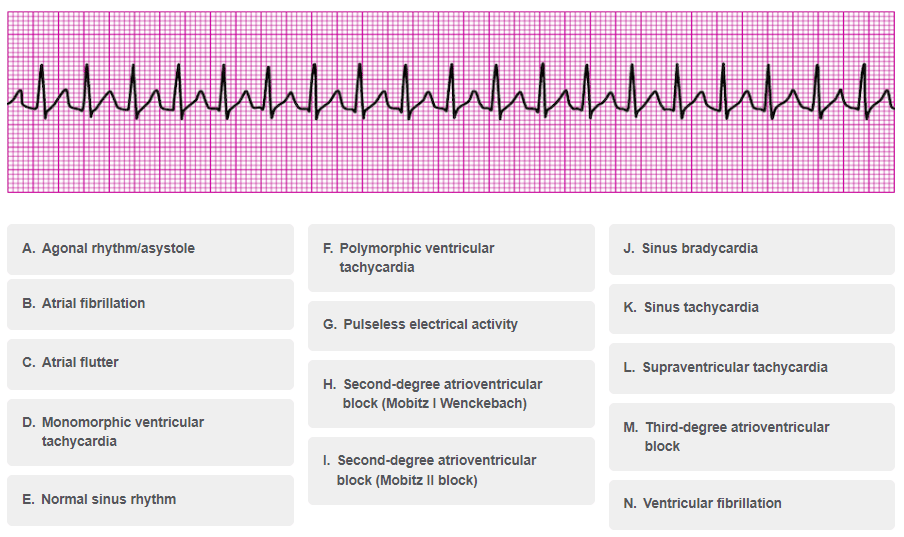
Answer: Supraventricular tachycardia.
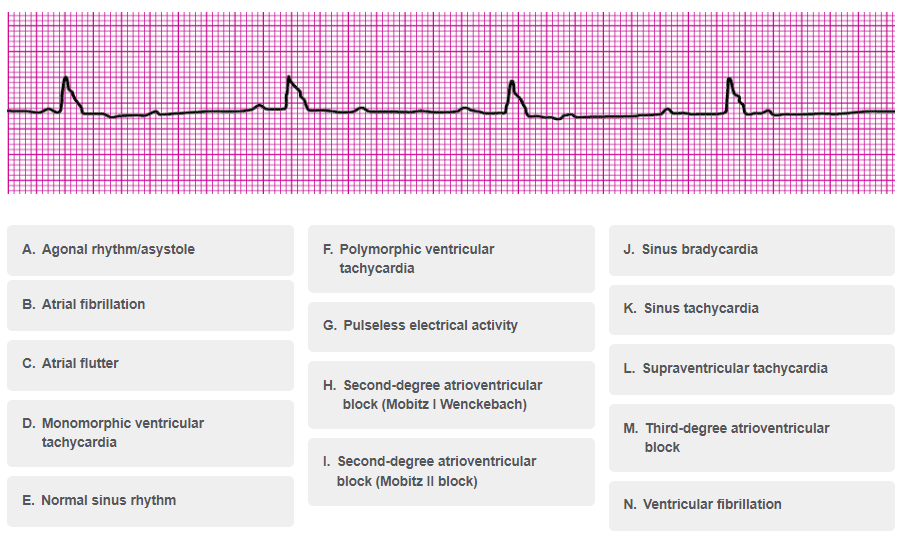
Answer: Third-degree atrioventricular block.
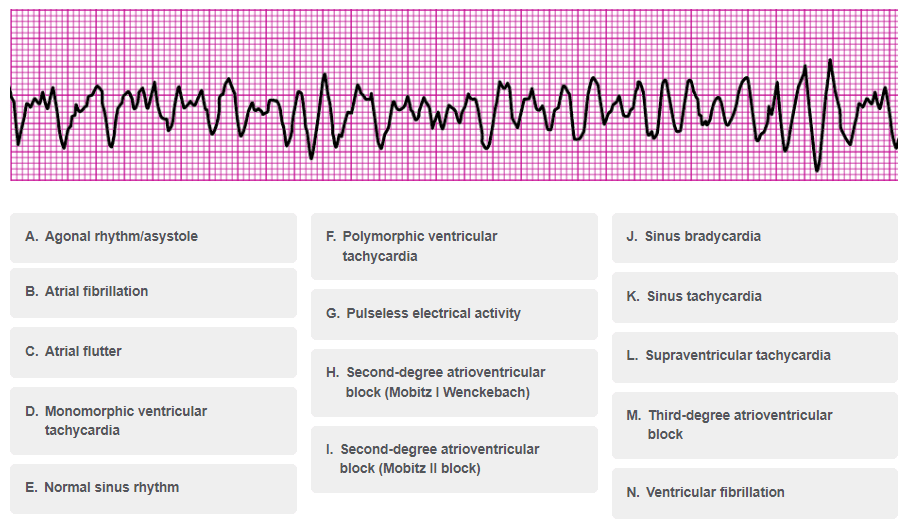
Answer: Ventricular fibrillation.
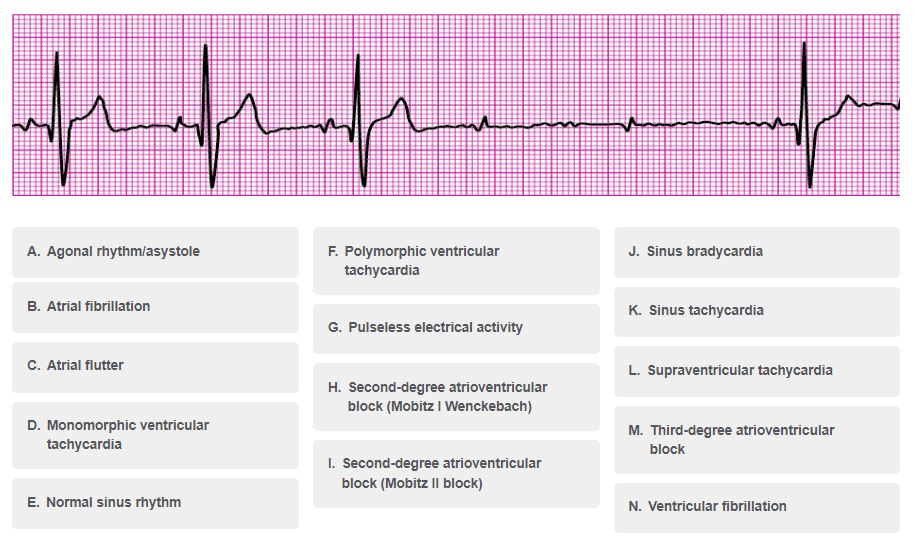
Answer: Second-degree atrioventricular block (Mobitz II block).
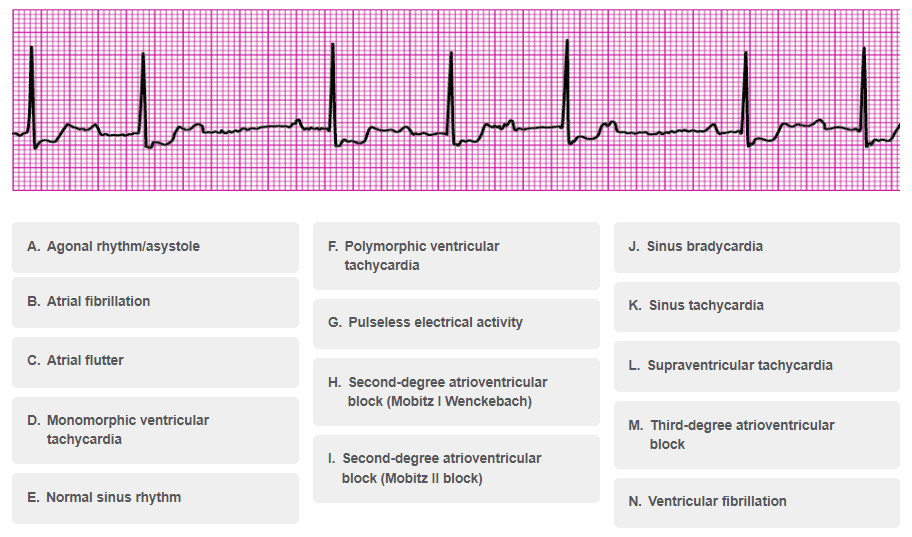
Answer: Second-degree atrioventricular block (Mobitz I Wenckebach).
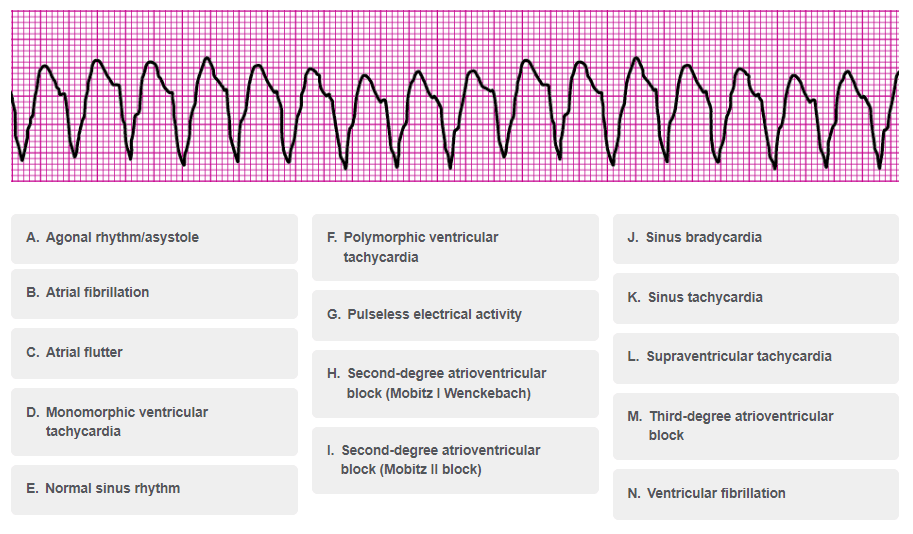
Answer: Monomorphic ventricular tachycardia.

Answer: Pulseless electrical activity.
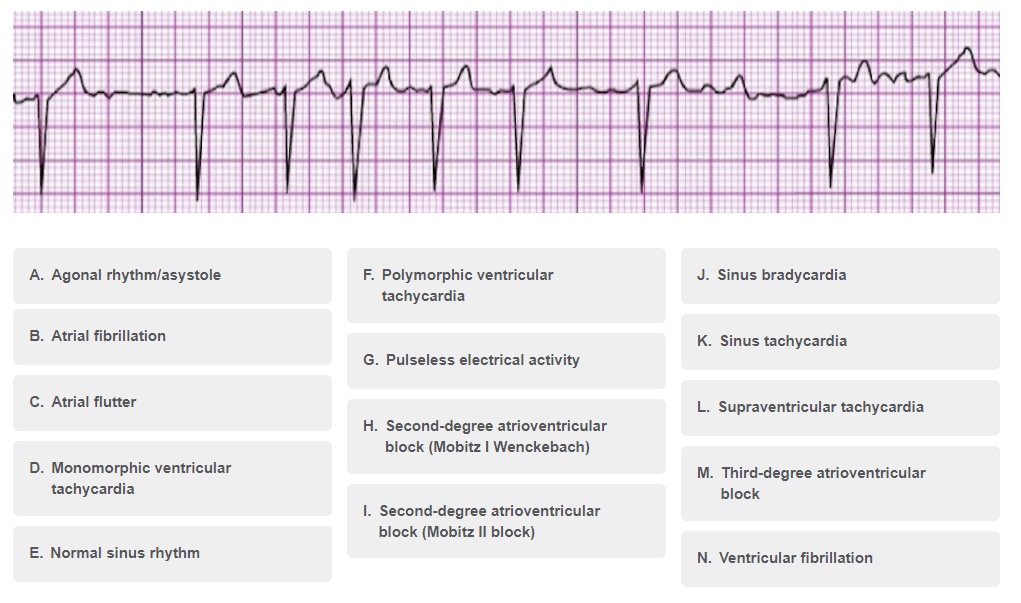
Answer: Atrial fibrillation.
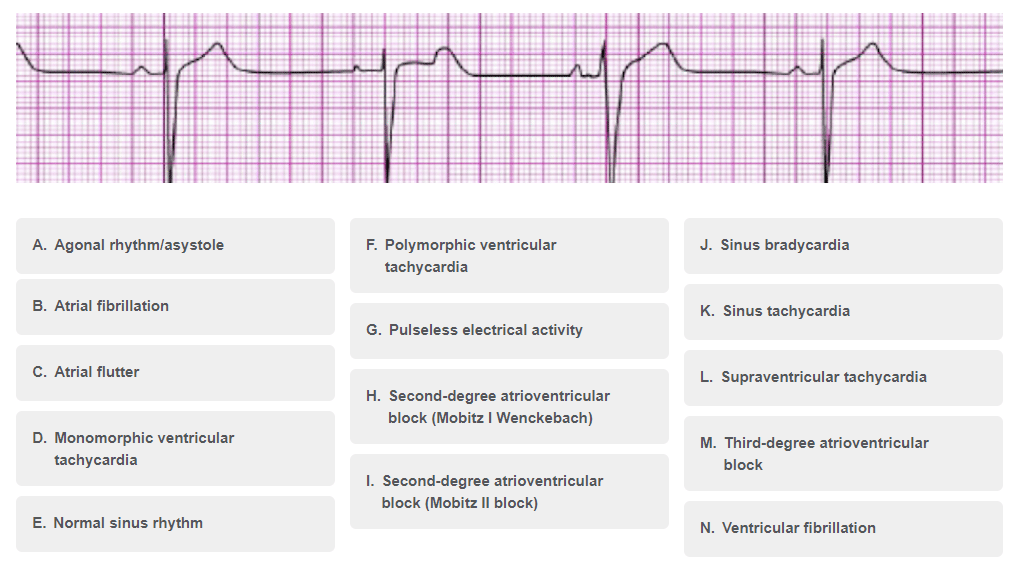
Answer: Sinus bradycardia.
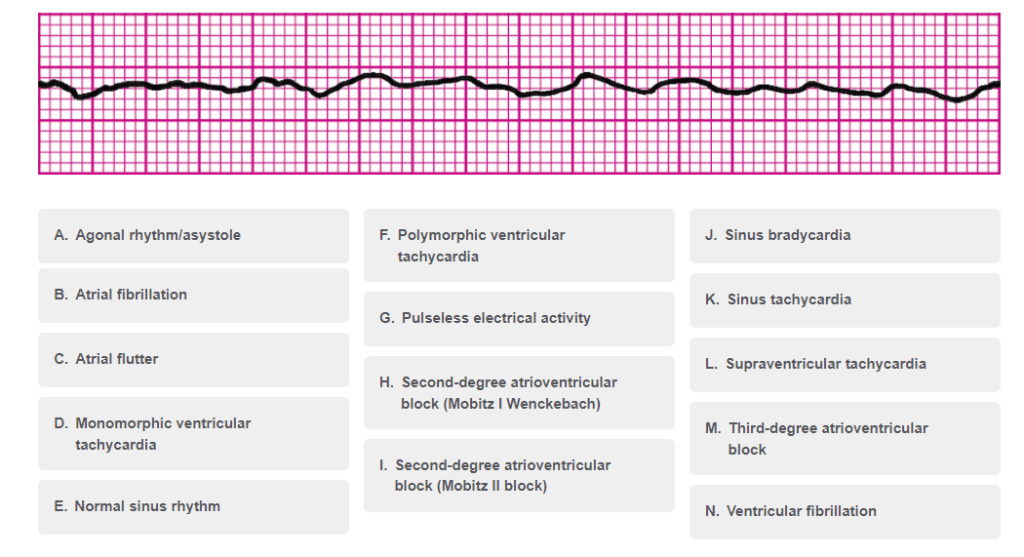
Answer: Ventricular fibrillation.
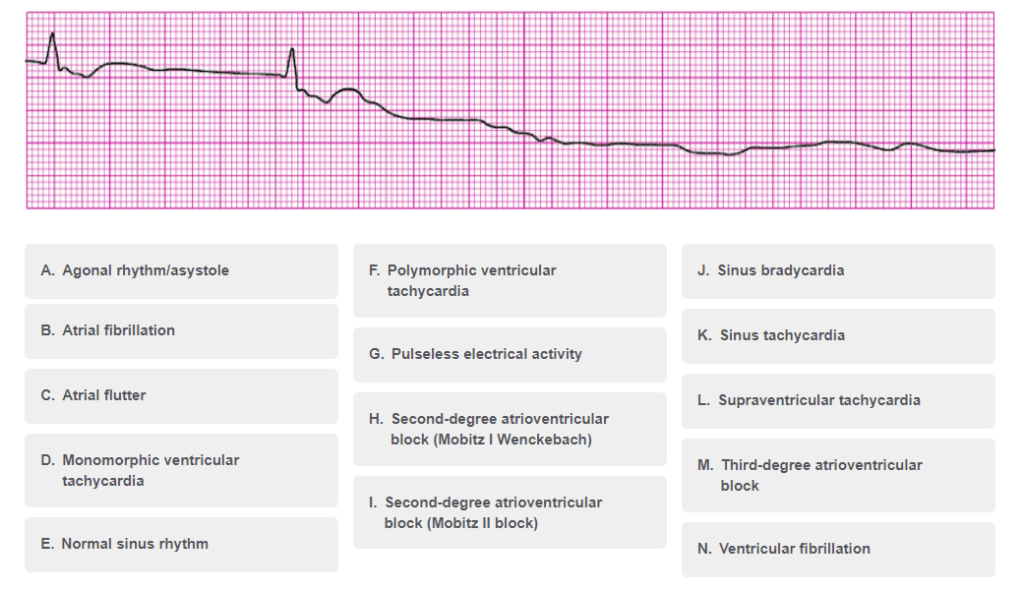
Answer: Agonal rhythm/asystole.
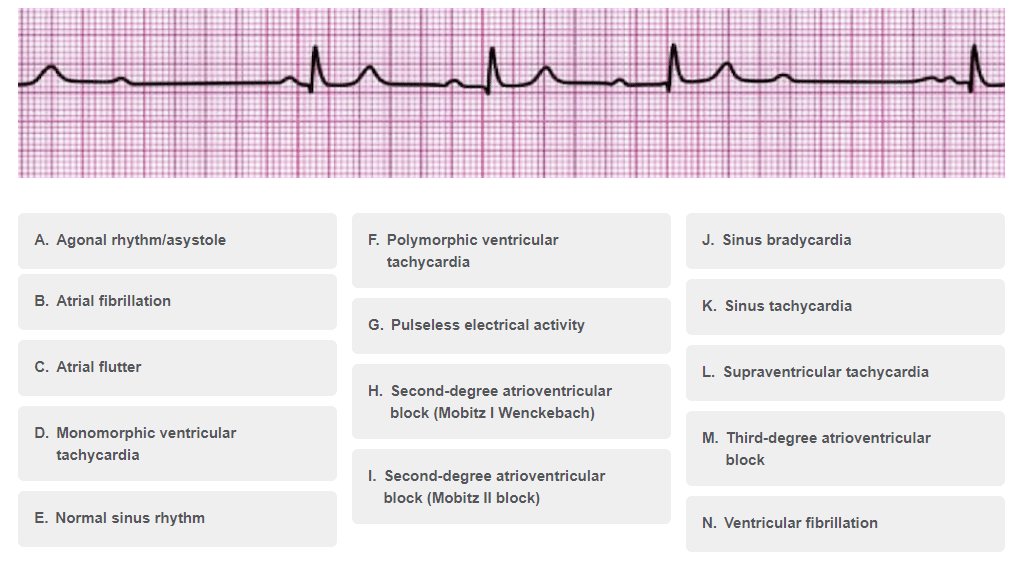
Answer: Second-degree atrioventricular block (Mobitz I Wenckebach).
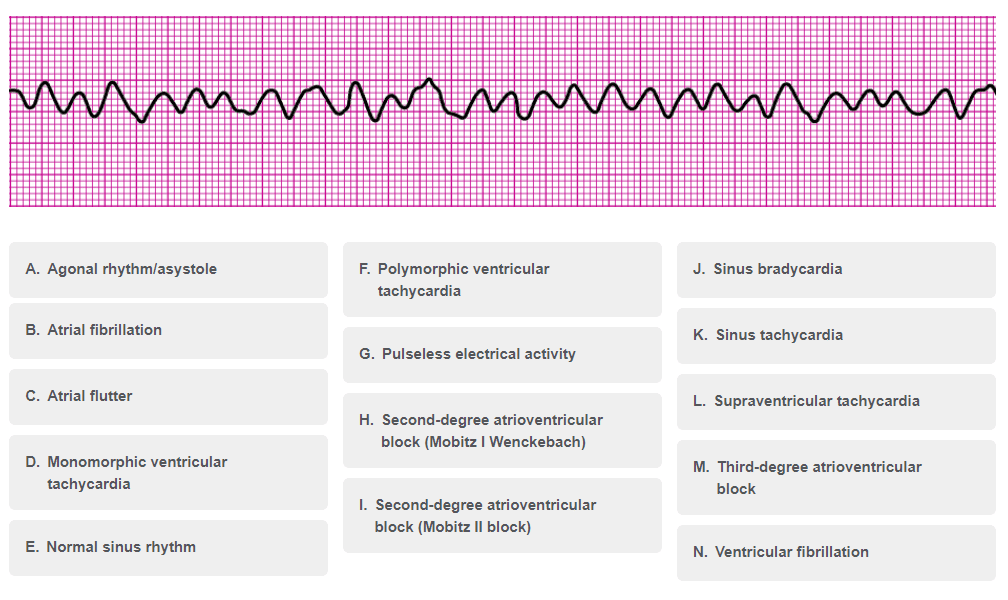
Answer: Ventricular fibrillation.
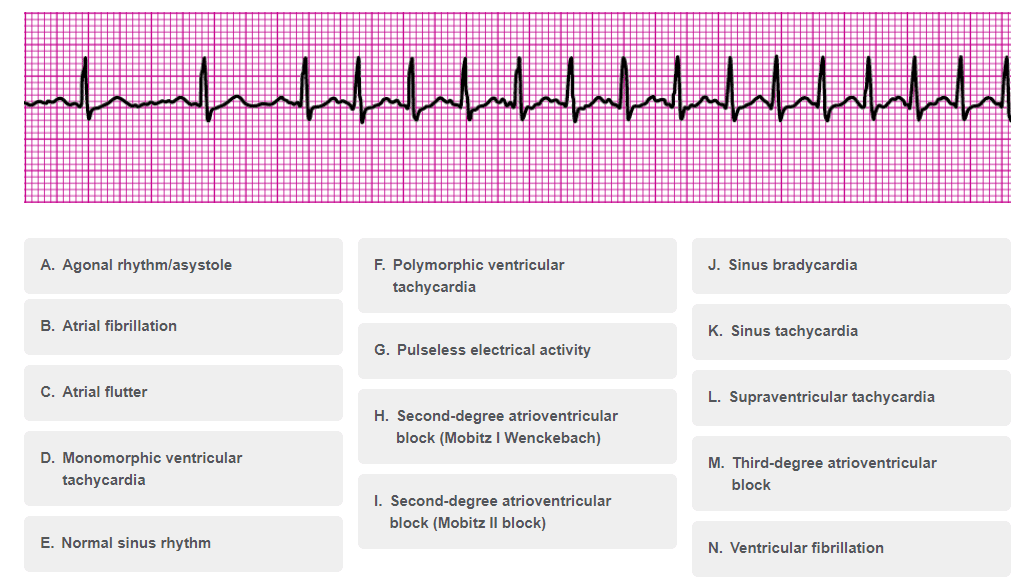
Answer: Supraventricular tachycardia.
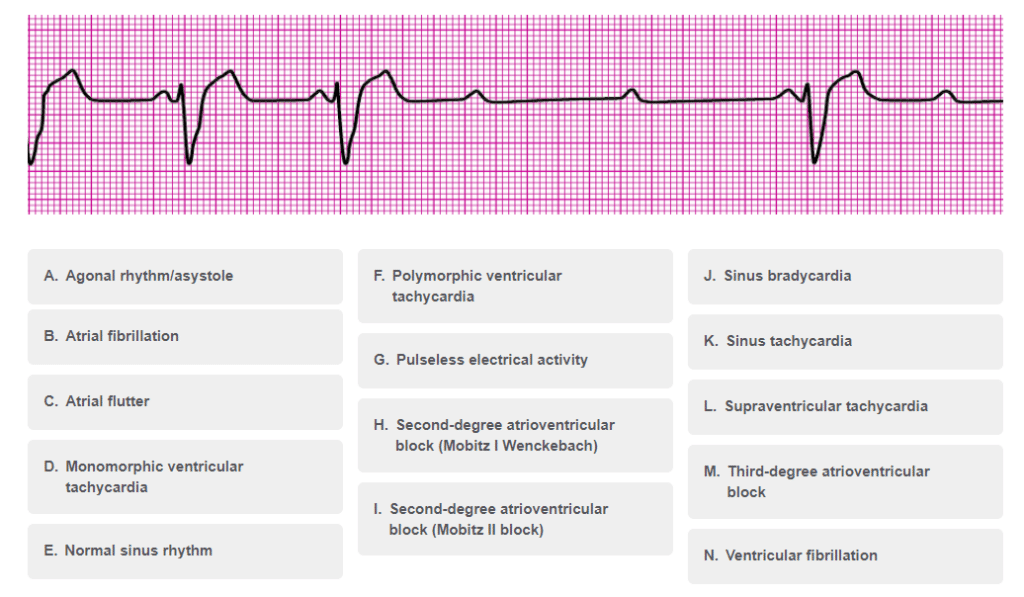
Answer: Second-degree atrioventricular block.
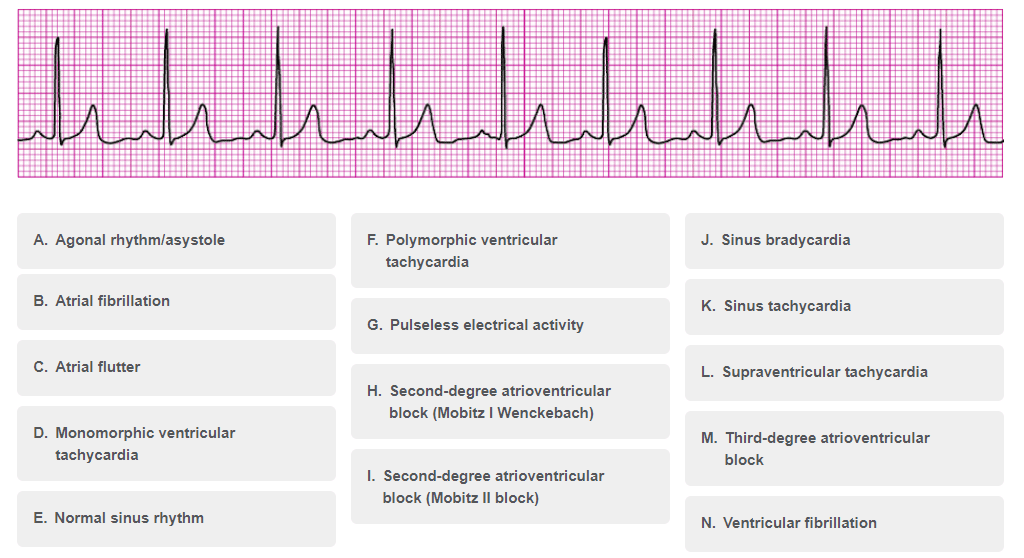
Answer: Normal sinus rhythm.
Section 2: Pharmacology Answers
You are caring for a 66-year-old man with a history of a large intracerebral hemorrhage 2 months ago. He is being evaluated for another acute stroke. The CT scan is negative for hemorrhage. The patient is receiving oxygen via nasal cannula at 2 L/min, and an IV has been established. His blood pressure is 180/100 mm Hg. Which drug do you anticipate giving to this patient?
Choose the correct option and select submit.
A. Nicardipine
B. rtPA
C. Glucose (D50)
D. Aspirin (Correct)
A patient has a rapid irregular wide-complex tachycardia. The ventricular rate is 138/min. He is asymptomatic, with a blood pressure of 110/70 mm Hg. He has a history of angina. What action is recommended next?
Choose the correct option and select submit.
A. Giving adenosine 6 mg IV bolus
B. Performing synchronized cardioversion
C. Seeking expert consultation (Correct)
D. Giving lidocaine 1 to 1.5 mg IV bolus
A patient with STEMI has ongoing chest discomfort. Heparin 4000 units IV bolus and a heparin infusion of 1000 units per hour are being administered. The patient did not take aspirin because he has a history of gastritis, which was treated 5 years ago. What is your next action?
Choose the correct option and select submit.
A. Give aspirin 162 to 325 mg to chew (Correct)
B. Give enteric-coated aspirin 75 mg orally
C. Give enteric-coated aspirin 325 mg rectally
D. Give clopidogrel 300 mg orally
What is the indication for the use of magnesium in cardiac arrest?
Choose the correct option and select submit.
A. Ventricular tachycardia associated with a normal QT interval
B. Shock-refractory ventricular fibrillation
C. Shock-refractory monomorphic ventricular tachycardia
D. Pulseless ventricular tachycardia-associated torsades de pointed (correct)
In which situation does bradycardia require treatment?
Choose the correct option and select submit.
A. Hypotension (Correct)
B. Systolic blood pressure greater than 100 mm Hg
C. Diastolic blood pressure greater than 90 mm Hg
D. 12-lead ECG showing a normal sinus rhythm
A patient is in cardiac arrest. High-quality chest compressions are being given. The patient is intubated, and an IV has been started. The rhythm is asystole. What is the first drug/dose to administer?
Choose the correct option and select submit.
A. Epinephrine 1 mg IV/IO (Correct)
B. Atropine 1 mg IV/IO
C. Atropine 0.5 mg IV/IO
D. Dopamine 2 to 20 mcg/kg per minute IV/IO
A patient with sinus bradycardia and a heart rate of 42/min has diaphoresis and a blood pressure of 80/60 mm Hg. What is the initial dose of atropine?
Choose the correct option and select submit.
A. 0.1 mg
B. 3 mg
C. 1 mg (Correct)
D. 0.5 mg
Which intervention is most appropriate for the treatment of a patient in asystole?
Choose the correct option and select submit.
A. Epinephrine (Correct)
B. Defibrillation
C. Transcutaneous pacing
D. Atropine
You arrive on the scene with the code team. High-quality CPR is in progress. An AED has previously advised “no shock indicated.” A rhythm check now finds asystole. After resuming high-quality compressions, which action do you take next?
Choose the correct option and select submit.
A. Perform endotracheal intubation
B. Call for a pulse check
C. Insert a laryngeal airway
D. Establish IV or IO access (Correct)
A patient is in refractory ventricular fibrillation and has received multiple appropriate defibrillation shocks, epinephrine 1 mg IV twice, and an initial dose of amiodarone 300 mg IV. The patient is intubated. Which best describes the recommended second dose of amiodarone for this patient?
Choose the correct option and select submit.
A. 1 mg/kg IV push
B. 300 mg IV push
C. 1 to 2 mg/min infusion
D. 150 mg IV push (Correct)
A patient with possible STEMI has ongoing chest discomfort. What is a contraindication to nitrate administration?
Choose the correct option and select submit.
A. Systolic blood pressure greater than 180 mm Hg
B. Anterior wall myocardial infarction
C. Use of a phosphodiesterase inhibitor within the previous 24 hours (Correct)
D. Heart rate less than 90/min
A patient is in pulseless ventricular tachycardia. Two shocks and 1 dose of epinephrine have been given. Which drug should be given next?
Choose the correct option and select submit.
A. Lidocaine 0.5 mg/kg
B. Epinephrine 3 mg
C. Adenosine 6 mg
D. Amiodarone 300 mg
A patient has sinus bradycardia with a heart rate of 36/min. Atropine has been administered to a total dose of 3 mg. A transcutaneous pacemaker has failed to capture. The patient is confused, and her blood pressure is 88/56 mm Hg. Which therapy is now indicated?
Choose the correct option and select submit.
A. Normal saline 250 mL to 500 mL bolus
B. Atropine 1 mg
C. Epinephrine 2 to 10 mcg/min (Correct)
D. Adenosine 6 mg
A 35-year-old woman has palpitations, light-headedness, and a stable tachycardia. The monitor shows a regular narrow-complex QRS at a rate of 180/min. Vagal maneuvers have not been effective in terminating the rhythm. An IV has been established. Which drug should be administered?
Choose the correct option and select submit.
A. Epinephrine 2 to 10 mcg/kg per minute
B. Atropine 0.5 mg
C. Lidocaine 1 mg/kg
D. Adenosine 6 mg (Correct)
A patient is in cardiac arrest. Ventricular fibrillation has been refractory to a second shock. Which drug should be administered first?
Choose the correct option and select submit.
A. Sodium bicarbonate 50 mEq IV/IO
B. Atropine 1 mg IV/IO
C. Epinephrine 1 mg IV/IO (Correct)
D. Lidocaine 1 mg/kg IV/IO
A 62-year-old man suddenly experienced difficulty speaking and left-sided weakness. He meets initial criteria for fibrinolytic therapy, and a CT scan of the brain is ordered. Which best describes the guidelines for antiplatelet and fibrinolytic therapy?
Choose the correct option and select submit.
A. Hold aspirin for at least 24 hours if rtPA is administered (Correct)
B. Give aspirin 162 to 325 mg to be chewed immediately
C. Give heparin if the CT scan is negative for hemorrhage
D. Give aspirin 120 mg and clopidogrel 75 mg orally
A 57-year-old woman has palpitations, chest discomfort, and tachycardia. The monitor shows a regular wide-complex QRS at a rate of 180/min. She becomes diaphoretic, and her blood pressure is 80/60 mm Hg. Which action do you take next?
Choose the correct option and select submit.
A. Perform electrical cardioversion (Correct)
B. Obtain a 12-lead ECG
C. Seek expert consultation
D. Establish IV access
A patient is in cardiac arrest. Ventricular fibrillation has been refractory to an initial shock. If no pathway for medication administration is in place, which method is preferred?
Choose the correct option and select submit.
A. Endotracheal tube
B. External jugular vein
C. IV or IO (Correct)
D. Central line
A monitored patient in the ICU developed a sudden onset of narrow-complex tachycardia at a rate of 220/min. The patient’s blood pressure is 128/58 mm Hg, the PETCO2 is 38 mm Hg, and the pulse oximetry reading is 98%. There is vascular access in the left arm, and the patient has not been given any vasoactive drugs. A 12-lead ECG confirms a supraventricular tachycardia with no evidence of ischemia or infarction. The heart rate has not responded to vagal maneuvers. What is your next action?
Choose the correct option and select submit.
A. Administer amiodarone 300 mg IV push
B. Perform synchronized cardioversion at 50 J
C. Administer adenosine 6 mg IV push (Correct)
D. Perform synchronized cardioversion at 200 J
A patient is in refractory ventricular fibrillation. High-quality CPR is in progress. One dose of epinephrine was given after the second shock. An antiarrhythmic drug was given immediately after the third shock. You are the team leader. Which medication do you order next?
Choose the correct option and select submit.
A. Epinephrine 3 mg
B. Epinephrine 1 mg (Correct)
C. Sodium bicarbonate 50 mEq
D. A second dose of the antiarrhythmic drug
Section 3: Practical Application Answers
After initiation of CPR and 1 shock for ventricular fibrillation, this rhythm is present on the next rhythm check. A second shock is given, and chest compressions are resumed immediately. An IV is in place, and no drugs have been given. Bag-mask ventilations are producing visible chest rise. What is your next intervention?

Answer: Give epinephrine 1 mg IV/IO.
Which action should you take immediately after providing an AED shock?
Choose the correct option and select submit.
A. Start rescue breathing
B. Prepare to deliver a second shock
C. Check the pulse rate
D. Resume chest compressions (Correct)
What is the maximum interval for pausing chest compressions?
Choose the correct option and select submit.
A. 25 seconds
B. 10 seconds (Correct)
C. 20 seconds
D. 15 seconds
You are providing bag-mask ventilations to a patient in respiratory arrest. How often should you provide ventilations?
Choose the correct option and select submit.
A. Every 6 seconds (Correct)
B. Every 10 seconds
C. Every 14 seconds
D. Every 12 seconds
What is the recommended depth of chest compressions for an adult victim?
Choose the correct option and select submit.
A. At least 2 inches (Correct)
B. At least 1.5 inches
C. At least 2.5 inches
D. At least 3 inches
What is the recommended compression rate for high-quality CPR?
Choose the correct option and select submit.
A. 90 to 100 compression per minute
B. 100 to 120 compressions per minute (Correct)
C. 70 to 80 compressions per minute
D. 50 to 20 compressions per minute
How often should you switch chest compressors to avoid fatigue?
Choose the correct option and select submit.
A. About every 2 minutes (Correct)
B. About every 5 minutes
C. About every 4 minutes
D. About every 3 minutes
A patient’s 12-lead ECG is transmitted by the paramedics and shows a STEMI. When the patient arrives in the emergency department, the rhythm shown here is seen on the cardiac monitor. The patient has resolution of moderate (5/10) chest pain after 3 doses of sublingual nitroglycerin. Blood pressure is 104/70 mm Hg. Which intervention is most important in reducing this patient’s in-hospital and 30-day mortality rate?

Answer: Reperfusion therapy.
Your patient is not responsive and is not breathing. You can palpate a carotid pulse. Which action do you take next?
Choose the correct option and select submit.
A. Apply an AED
B. Start rescue breathing (Correct)
C. Obtain a 12-lead ECG
D. Start an IV
How does complete chest recoil contribute to effective CPR?
Choose the correct option and select submit.
A. Reduces rescuer fatigue
B. Allows maximum blood return to the heart (Correct)
C. Reduces the risk of rib fractures
D. Increases the rate of chest compressions
A patient has been resuscitated from cardiac arrest. During post-ROSC treatment, the patient becomes unresponsive, with the rhythm shown here. Which action is indicated next?

Answer: Give an immediate unsynchronized high-energy shock (defibrillation does).
A patient was in refractory ventricular fibrillation. A third shock has just been administered. Your team looks to you for instructions. What is your next action?

Answer: Resume high-quality chest compressions
You are the code team leader and arrive to find a patient with CPR in progress. On the next rhythm check, you see the rhythm shown here. Team members tell you that the patient was well but reported chest discomfort and then collapsed. She has no pulse or respirations. Bag-mask ventilations are producing visible chest rise, and IO access has been established. Which intervention would be your next action?

Answer: Epinephrine 1 mg.
A 35-year-old woman presents with a chief complaint of palpitations. She has no chest discomfort, shortness of breath, or light-headedness. Her blood pressure is 120/78 mm Hg. Which intervention is indicated first?

Answer: Vagal maneuvers.
You arrive on the scene to find CPR in progress. Nursing staff report the patient was recovering from a pulmonary embolism and suddenly collapsed. Two shocks have been delivered, and an IV has been initiated. What do you administer now?

Answer: Epinephrine 1 mg IV.
Your patient is a 56-year-old woman with a history of type 2 diabetes who reports feeling dizzy. She is pale and diaphoretic. Her blood pressure is 80/60 mm Hg. The cardiac monitor documents the rhythm shown here. She is receiving oxygen at 4 L/min by nasal cannula, and an IV has been established. What do you administer next?

Answer: Atropine 1 mg IV.
What action minimizes the risk of air entering the victim’s stomach during bag-mask ventilation?
Choose the correct option and select submit.
A. Ventilating until you see the chest rise (Correct)
B. Delivering the largest breath you can
C. Ventilating as quickly as you can
D. Squeezing the bag with both hands
Which action is likely to cause air to enter the victim’s stomach (gastric inflation) during bag-mask ventilation?
Choose the correct option and select submit.
A. Giving breaths over 1 second
B. Ventilating too quickly (Correct)
C. Providing just enough volume for the chest to rise
D. Providing a good seal between the face and the mask
A 45-year-old woman with a history of palpitations develops light-headedness and palpitations. She has received adenosine 6 mg IV for the rhythm shown here, without conversion of the rhythm. She is now extremely apprehensive. Her blood pressure is 128/70 mm Hg. What is the next appropriate intervention?

Answer: Administer adenosine 12 mg IV.
A patient becomes unresponsive. You are uncertain if a faint pulse is present. The rhythm shown here is seen on the cardiac monitor. An IV is in place. Which action do you take next?

Answer: Start high-quality CPR.
How Many Questions Are on the ACLS Pre Test?
The number of questions on the ACLS Precourse Self-Assessment test may vary depending on the specific version or provider of the test. Generally, the pretest has around 60 questions, covering the three primary sections: rhythm recognition, pharmacology, and practical application. It is essential to check with your specific course provider for the exact number of questions on their version of the ACLS pretest.
Can I Retake ACLS Pretest?
Yes, you can retake the ACLS Precourse Self-Assessment test if you do not achieve the minimum required score of 70% or if you want to improve your understanding of the material. There is typically no limit on how many times you can retake the pretest. However, checking with your specific course provider for their retake rules and guidelines is essential.
The pretest aims to help you identify areas that may require additional review and practice before attending the ACLS Course. If you do not pass the pretest initially, take the time to study the material, focusing on the areas you struggled with, and then retake the test to ensure you are adequately prepared for the course.
What is on the ACLS Pretest?
The ACLS Precourse Self-Assessment test evaluates a student’s knowledge and proficiency before attending the ACLS course. The pretest generally covers three primary sections:
- Rhythm recognition: This section assesses the student’s ability to identify various cardiac rhythms, including normal sinus rhythms, atrial fibrillation, ventricular tachycardia, etc. It tests their knowledge of ECG interpretation and recognition of life-threatening arrhythmias.
- Pharmacology: In this section, students are tested on their understanding of ACLS medications, such as epinephrine, amiodarone, and adenosine. It covers their indications, contraindications, dosages, and administration routes. Students should also be familiar with the proper sequence of drug administration during cardiac arrest and other emergencies.
- Practical application: This part of the pretest focuses on the application of ACLS algorithms, protocols, and guidelines for managing various cardiovascular emergencies, including cardiac arrest, symptomatic bradycardia, tachycardia, and acute coronary syndromes.
The exact content and number of questions on the ACLS pretest may vary depending on the specific course provider or institution. It is essential to review the course materials and guidelines provided by your course provider to ensure adequate preparation for the pretest and the ACLS course.




Hello! I just would like to give a huge thumbs up for the great info you have here on this post. I will be coming back to your blog for more soon.